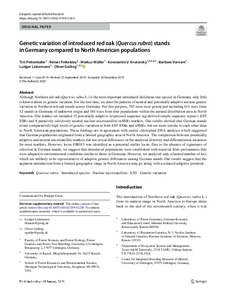Genetic variation of introduced red oak (Quercus rubra) stands in Germany compared to North American populations : научное издание
Скачать файл:
URI (для ссылок/цитирований):
https://elib.sfu-kras.ru/handle/2311/137959Автор:
Pettenkofer Tim
Finkeldey Reiner
Mueller Markus
Krutovsky Konstantin V.
Vornam Barbara
Leinemann Ludger
Gailing Oliver
Дата:
2020Журнал:
EUROPEAN JOURNAL OF FOREST RESEARCHКвартиль журнала в Scopus:
даКвартиль журнала в Web of Science:
даСтатья из журнала. Научное издание.
Аннотация:
Although Northern red oak (Quercus rubra L.) is the most important introduced deciduous tree species in Germany, only little is known about its genetic variation. For the first time, we describe patterns of neutral and potentially adaptive nuclear genetic variation in Northern red oak stands across Germany. For this purpose, 792 trees were genotyped including 611 trees from 12 stands in Germany of unknown origin and 181 trees from four populations within the natural distribution area in North America. Our marker set included 12 potentially adaptive (expressed sequence tag-derived simple sequence repeat = EST SSR) and 8 putatively selectively neutral nuclear microsatellite (nSSR) markers. Our results showed that German stands retain comparatively high levels of genetic variation at both EST-SSRs and nSSRs, but are more similar to each other than to North American populations. These findings are in agreement with earlier chloroplast DNA analyses which suggested that German populations originated from a limited geographic area in North America. The comparison between potentially adaptive and neutral microsatellite markers did not reveal differences in the analyzed diversity and differentiation measures for most markers. However, locus FIR013 was identified as a potential outlier locus. Due to the absence of signatures of selection in German stands, we suggest that introduced populations were established with material from provenances that were adapted to environmental conditions similar to those in Germany. However, we analyzed only a limited number of loci which are unlikely to be representative of adaptive genetic differences among German stands. Our results suggest that the apparent introduction from a limited geographic range in North America may go along with a reduced adaptive potential.

